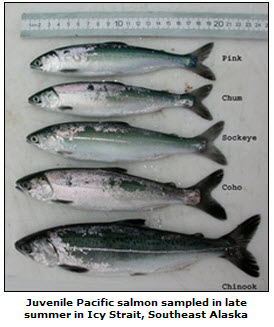GLOBEC 2000: Factors Affecting the Distribution of Juvenile Salmon in the Gulf of Alaska
J. Helle (NMFS/AFSC, Auke Bay Laboratory)
E. D. Cokelet (Pacific Marine Environmentla Laboratory),
E. V. Farley, Jr. (NMFS/AFSC, Auke Bay Laboratory),
A. B. Hollowed (NMFS/AFSC),
P. J. Stabeno (Pacific Marine Environmental Laboratory)
"Remarkable changes in atmospheric, oceanic and biological conditions have occurred in recent decades in the North Pacific Ocean including declines in the marine survival of some salmon stocks. Fishery scientists generally agree that in the first few months after leaving freshwater, salmon survival and growth are linked to oceanic variability. The purpose of this research is to focus National Marine Fisheries Service studies on the GLOBEC region, augment oceanographic measurements and determine what biological and physical factors influence the distribution of juvenile salmon. Three general hypotheses are explored in this proposal: (1) juvenile salmon prefer the buoyancy-driven Alaska Coastal Current (ACC) at the head of the Gulf of Alaska, (2) they associate with oceanic temperature, salinity, current and prey fields, and (3) they migrate landward of Kodiak Island in the ACC rather than seaward in the Alaskan Stream. Annual, summer cruises aboard a chartered fishing vessel will catch juvenile salmon on 10 transects between Yakutat Bay and Kodiak Island. The vessel will be outfitted with a thermosalinograph to measure sea-surface temperature and salinity, and with an Acoustic Doppler Current Profiler (ADCP) - each operating continuously for fine-scale resolution. Modeled tidal currents will be removed from ADCP measurements to reveal the mean flow fields. At each trawl site, temperature and salinity profiles will provide water-column properties, and bongo-net hauls will give zooplankton distributions. Stomach samples from juvenile salmonids will be analyzed in the laboratory for diet composition and compared with zooplankton distributions. Analysis of salmon otoliths for hatchery thermal marks and Genetic Stock Identification techniques will be used to determine the home stream of hatchery and wild stocks in the Gulf of Alaska and their distribution with respect to oceanographic regimes. Retrospective analysis of catch per unit effort versus oceanographic and prey factors will reveal what affects the distribution of pink, chum, coho and sockeye salmon in the study region. Proxies for bio-physical factors will be developed and compared with salmon-run size."(project proposal)
Data Collection Details:
Types: CTD profiles, ADCP profiles of ocean current, juvenile salmonid catch statistics from trawls, salmonid stomach samples analyzed for diet composition, salmonid otolith analyses, Genetic Stock Identification, zooplankton distributions from bongo-net hauls
Platform: Chartered fishing vessel
Spatial extent: 10 transects perpendicular to the coast between Yakutat Bay and Kodiak Island
Temporal extent: ~2 weeks each July-August of 2001-2004.


 ©2025 Biological and Chemical Oceanography Data Management Office.
©2025 Biological and Chemical Oceanography Data Management Office.
